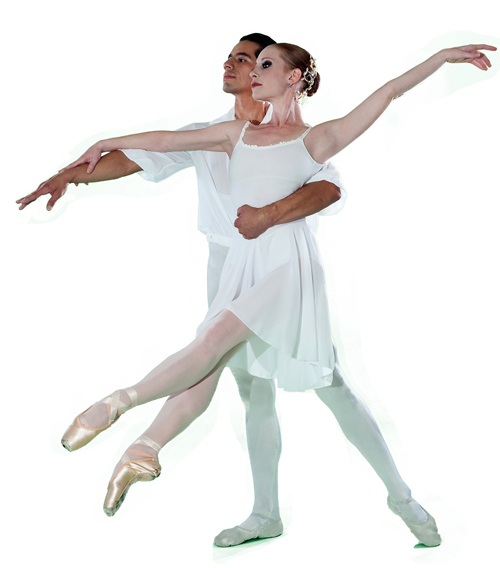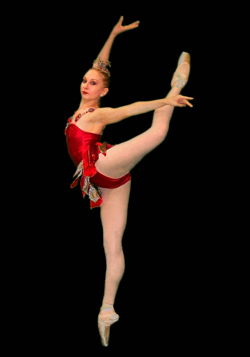
By Sheila Orysiek

SAN DIEGO — City Ballet of San Diego’s “Celebrate Balanchine” program on November 7, 2010 was an ambitious endeavor – not flawless – but another notch in the Company’s escutcheon of accomplishments. The Company is still based in the historic jewel box of a theatre, The Spreckels; however, the exigencies of the economic environment necessitated the use of taped music rather than a live orchestra. But, whatever it takes to remain active and viable – so be it.

“Rubies” (Stravinsky) brought back memories of those heady days when Balanchine was exploring shape and time. It became for me a scenario of how the jewels in a display window – after the shop has closed and the streets are empty – might cavort, swiveling about to cause each facet to dazzle and shimmer. Megan Jacobs used her long legs to good effect, sparkling her way across the stage, a worthy addition in her second season as a Company member.
Janica Smith and Gerardo Gil looked more and more at home with the fizzy choreography, so much of it against the classical grain, and yet still its child. I loved her absolutely “on time” balances delivered with a smile. The women of the corps acquitted themselves well, too, but a couple of them seemed to draw impetus for movement from the feet rather than the body’s center. The men matched one another in tempo but not always in amplitude.
“Valse-Fantaisie” (Glinka) was a welcome respite after “Rubies” – it flowed – moving but not restless. Emily Kirn was a pleasure to the eye. Her able partner, Kyle Rivieccio, had a momentary bobble in a difficult turn sequence, but held onto it and ended with timely grace. So much of presentation is about how those bound-to-occur bobbles are permitted – or not – to interrupt the flow. And, he did not permit it to interrupt him.
Of the four other women, one took a full body fall to the floor. As Principal Dancer, New York City Ballet, Edward Villella said in his autobiography sometimes the audience needs to be reminded that flesh and blood isn’t perfect and dancers do it without a net. It’s not an excuse but does further understanding. Pick yourself up with grace and get on with it – and she did.
“Sonatine” (Ravel) was a feast of musical exploration both by Balanchine and the dancers: Ariana Samuelsson and Gerardo Gil. Both of them made it look spontaneous which is surely the aim of all that time spent in rehearsal. This was a Company premiere of this ballet and it was beautifully danced. The piano on stage was played by Nina Deering.
“Walpurgisnacht” (Gounod), another Company premiere, filled the stage with twenty-five dancers and with all the challenges that, as well as the dramatic music, presents it was the most successful group effort of the evening. Samuelsson and John Henry Reid were both a treat to the eye but I would have liked to see her emotionally let go – just let it fly and see what happens. Reid’s full out split tour jeté as well as in a la second stayed aloft long enough to engrave a mental image.
The corps was especially good in this difficult ballet; loose long hair swirling in the turns became part of the choreography. It seems the greater the challenge the more they gave of themselves.
Another version of “Walpurgisnacht” choreographed by Leonid Lavrovsky was my introduction to live ballet on stage when the Bolshoi appeared in Philadelphia’s marvelous Academy of Music. The thrill, verve and energy were breathtaking. Though there can be no comparison between the two choreographers (Balanchine and Lavrovsky) nor the very different styles of the Bolshoi and City Ballet of San Diego (which derives its heritage more from the Kirov-Mariinsky via Artistic Director Steven Wistrich’s Balanchine based schooling) the look of joy and sense of “abandonment” on the faces and in the impetus of the Bolshoi dancers is a wondrous thing. Is it beyond imagining that it could be married to the Balanchine version?
I would love to see the Company do a full evening of Fokine; same artistic parentage as Balanchine but separate choreographic destinations.
*
Dance critic Orysiek is based in San Diego